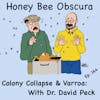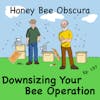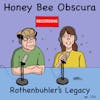What To Do With Cappings (139)

It seems that everyone talks about managing bees and selling honey. There's also a lot of discussion about extracting honey - such as: removing bees from the supers, what kind of extractor works best, uncapping and even bottling. But what about all...
 It seems that everyone talks about managing bees and selling honey. There's also a lot of discussion about extracting honey - such as: removing bees from the supers, what kind of extractor works best, uncapping and even bottling. But what about all those wet wax cappings laying around? Hopefully, they're mostly in some sort of pan, tray or tank. But just what do you do with those cappings?
It seems that everyone talks about managing bees and selling honey. There's also a lot of discussion about extracting honey - such as: removing bees from the supers, what kind of extractor works best, uncapping and even bottling. But what about all those wet wax cappings laying around? Hopefully, they're mostly in some sort of pan, tray or tank. But just what do you do with those cappings?
In this episode, Kim and Jim talk about the cappings and how a hobbyest can process and melt them down to use them in candles or even to sell as blocks of pure beeswax. How have they handled them (you may be surprised) and is it work your time to even bother?
Listen in as Kim and Jim talk through their different approaches to dealing with this little discussed topic of bee hive products.
______________________
Thanks to Betterbee for sponsoring today's episode. Betterbee’s mission is to support every beekeeper with excellent customer  service, continued education and quality equipment. From their colorful and informative catalog to their support of beekeeper educational activities, including this podcast series, Betterbee truly is Beekeepers Serving Beekeepers. See for yourself at www.betterbee.com
service, continued education and quality equipment. From their colorful and informative catalog to their support of beekeeper educational activities, including this podcast series, Betterbee truly is Beekeepers Serving Beekeepers. See for yourself at www.betterbee.com
______________________
Honey Bee Obscura is brought to you by Growing Planet Media, LLC, the home of Beekeeping Today Podcast.
Music: Heart & Soul by Gyom, All We Know by Midway Music, original guitar music by Jeffrey Ott
Copyright © 2023 by Growing Planet Media, LLC

Episode 139 – What To Do With Cappings
Kim Flottum: Jim, how you doing? It's been a while.
Jim Tew: Yes, it has been. I'm actually all right. Late summer, having a good time in life, so it's all okay.
Kim: You say late summer, and every time a beekeeper hears the term late summer, you think of harvesting and all of the things that go with that to get ready to do it. What do you do afterwards? It's just a whole flood of things, but I'll tell you the thing that probably gives me the most to think about is cappings.
Jim: Cappings? Out of all that you just listed, cappings is what comes to the top of your pile? I understand it though. It's that season of the year when we don't keep bees, but we work with the bees' product that they made.
Kim: Hi, I'm Kim Flottum.
Jim: I'm Jim Tew.
Kim: I guess it sounds like today we're going to talk about dealing with cappings.
Jim: Well, I didn't realize that specifically, but it does sound that way. Dealing with cappings.
Introduction: You are listening to Honey Bee Obscura, brought to you by Growing Planet Media, the folks behind Beekeeping Today Podcast. Each week on Honey Bee Obscura, hosts Kim Flottum and Jim Tew explore the complexities, the beauty, the fun, and the challenges of managing honeybees in today's world. Get ready for an engaging discussion to delight and inform all beekeepers. If you're a long-timer or just starting out, sit back and enjoy the next several minutes as Kim and Jim explore all things honeybees.
Kim: Over 40 years, my thought has evolved on what to do with cappings. When I was making more honey, or I was working with people, or working for people who made a lot of honey, cappings were an important part of the business, their business. Even when I was making enough honey to worry about, I had to do something with cappings. I never figured it out exactly easy.
Jim: I was waiting for you to take a pause here because the devil's in the details, isn't it? Did you uncap five supers or did you uncap 500 supers? Because if you've got five supers, what you've really got is kind of a small mess. If you've got 500 supers, there's a high-quality wax crop there that is a secondary processing procedure to the honey. You and me, we're in the five super category many times.
Kim: Or less.
Jim: What we've got is a small amount. That makes a difference, does it? On the type of equipment you use, what you do with it. Indeed, Kim, and honestly, is it even worth it, you got such a small amount?
Kim: I think you hit the nail on the head. What's your time worth? If your time is worth as much as mine is, cappings from five supers probably isn't going to justify my time.
Jim: Well, I know what you mean. It just depends on the mood I'm in. I don't want to sound negative to the listeners, but first of all, how hard did I work? How hard was it to get the supers off? How big a problem was it to get the extracting line set up? How much energy do I have left? Since cappings comes toward the end, then cappings always gets a lick and a promise in my case. I'll work on those cappings tomorrow. There's not that many of them. I've got a pot, I'll heat them up.
Then tomorrow turns into more tomorrows. The next thing, that quart of cappings has been sitting around for three months. By then, nothing's wrong with them. Beeswax is remarkable resilient and will sit there for years if you had to, and years. It can still be processed, but the question is, since I guess there's no urgency, I just keep putting it off. Let's just say that time and energy and all those kinds of things are irrelevant, and I wanted that wax. Do you have a technique that you go to, that you would go to if you wanted to melt that wax down?
Kim: Yes, I do. Even when I had a few hives, a few more hives, the technique that I use is pretty similar to what lots of people do. I would uncap my frames and I would put those frames in the extractor. When the extractor was full, then I would begin extracting. I'd spin the extractor. At the bottom of the extractor, there's a gate. I would open that gate. As I was turning the extractor, the honey that came out came down to the bottom of the extractor and then went out through that gate.
Now, below that gate, I had two five-gallon pails, one above the other. The top one had a very coarse screen, and on the same pail, a medium screen, which got most of the stuff that I didn't want in my honey out. That pail drained into another pail, which had an incredibly fine filter. When that was done, that's as much filtering as my honey ever got. When I was done, there would be cappings, some framed dead bees, who knows what else, small hive beetles, who knows what else was going to be in that top filter, but by the time it got to my bottom pail, it was good enough for me.
Jim: The mental image I've got of what you just described, tell me if I'm wrong, there's a waterfall that is flowing over several falls, and at the top of the falls is the coarsest filter, and then there's a filter at every fall, and then the finest filter is at the bottom. Then what I'm left with at the bottom of my hypothetical waterfall is good, clear water. Everything has been trapped in the filters upstream.
You're using some kind of multi-screen device. You're more sophisticated than I was. I would frequently, if I had a small amount, just let them drain either in the cappings tank, if I had some kind of strainer system in that, or I would frequently, because of my lifelong background in paint and paint supplies, I would go to a paint supply company and buy a paint filter, and put those cappings in that filter and then suspend them above a bucket and let them drip for a couple of days.
I didn't get the same sophistication that you got. You got cappings out of the honey and you got clean honey at the other end because in my case, I had the cappings that I had dried, but I still had the detritus floating in the honey to deal with.
Kim: Well, I didn't have that. Also, what I did have was a three-frame extractor. We're not talking gallons of honey a day.
Jim: Right. Yes. No, I understand. I had found too, we're talking about cappings, but it's always-- the devil's in the details. If you're going to bottle the honey that you've just processed, you really have to get everything out of it. The consumer doesn't want to know that this was ever around insects. We, as beekeepers, really need to protect our consumers, our honey consumers because if you just let one bee get by, that'd be horrific. If a bee turned up at a bottle of honey that you sold at a farmer's market, it would not be seen as, "Oh, well, it's just one bee. You got the other 59,999 out, but one got by you." No, you can't have any get by.
Everything that floats after a couple of days in my warm shop here, where I extract, all the pieces of beeswax, maybe an occasional splinter off the end bar of a frame, a dead bee now and then, all those things come to the top. Then of course you rake that off and then I would put that over in the cappings tank. It was just a minimal amount.
We're going on and on about this. What did you do with the cappings when you got them? How did you melt them down? You've got this small amount of cappings that we've made this mess with. We've got all these strainers everywhere, but once you finally got the cappings, what'd you do then?
Kim: Well, unlike lots of people, back then I used to have to look at what's my time worth. If I had two or three frames, or two or three supers that I'd uncapped, the amount of wax that I would collect, what I'd have to do to it after I collected it cost me more than cleaning it and selling it to somebody. My time wasn't worth-- the cappings wasn't worth the time that I was spending taking care of them. I'll tell you where they went. They went on top of a hive out in the yard to let them bees clean them off. When that was done, in the trash.
Jim: All right. That's one way of rendering cappings, Kim. That's certainly one way of rendering cappings. Just take a break while I think about that.
Betterbee: At Betterbee, we know you have many options for where you choose to get your wooden hive boxes and frames. We work closely with our sister company, Humble Abodes in Maine, to bring you high-quality woodenware featuring tight-fit assembly, available in a variety of great options to meet your needs. Whether you choose select, commercial, or budget-grade boxes or frames, you can count on quality milling of locally sourced Eastern white pine. Shop all woodenware at betterbee.com.
Jim: I know where you're coming from, Kim, that if you got just that small amount and the bees have cleaned it up, we talked to beekeepers, I've done it myself. All I would do many times is take those cappings after I'd let the bees rummage around. I never did it outside. I know people a lot would put cappings outside and let the bees come rob, do whatever they could do to clean that up because it's mostly honey. Those cappings are mostly honey.
Let the bees dry it out as much as possible. Then I'd put it back in that paint filter bag I was talking about and run water over that and try to wash off most of the honey. What was left with those wet wax cappings-- let me hear you say that three times real fast.
Kim: I'll try.
Jim: [chuckles] People would do strange things to me at the time, but they made perfect sense. They would go over to a secondhand store and buy a used Crock-Pot if you had just a small amount and then put some water in there. It doesn't matter how much, just enough to make the wax float. Then heat that Crock-Pot, the wax would melt and would float on the water. Then what you're left with was, like you said, a very small amount of pristine canary yellow beeswax.
It is really high-quality wax. You can use a pot, a pan, but I got to tell you that any pot or pan container that you use, it needs to be something that you only plan for evermore after that to use for those cappings because it's just about impossible to clean them. I would get a small amount of wax out of the deal, but it's like you said, you had to go to the store and get that melting device.
You've got to find a pan. You've got to get the burner set up. Don't use gas. I mean, I rarely use gas and people always say to use double boilers. Well, what you and I are describing so far is enough of a headache that a double boiler is just going to add to it, but while you're at that secondhand store, see if you can find the double boiler that happens to be there and heat that with secondary heat, not with direct heat. We need to say that that wax is stunningly flammable. Even a small amount is going to still make a small fire if it gets away from you. So, be careful when using that around an open flame or heating directly because of the risk of a fire.
Kim: Yes, I've always been aware of that. One of the reasons that I just kind of looked at it as almost more trouble than it's worth, and here's one more reason why, is I don't want to kill myself blowing up my garage with wax fumes igniting because-- To me, I'm not selling honey to make money. I'm not selling honey to pay for anything. I'm extracting honey and I get to give it to my friends. After that, everything comes in third, is being able to share what my bees did with the friends that I have.
Jim: Well, that makes sense. I mean, you sound like a typical beekeeper who drives commercial people crazy, giving your product away, but it's a coveted gift. In my case, I've got close neighbors. It's a unique gift that I can give the honey, to my neighbors, give the honey to them because it came from their yards too. It's a little bit like a product from their garden. I can't condemn you for that. You ever used a solar wax melter? Why wouldn't you do that instead of just throwing them away, put them in a solar wax melter? What's up with that?
Kim: I had one for a lot of years and I used it almost every year until something happened. I don't know. One year it wasn't there anymore and I don't remember what happened, but yes, I would throw these wet cappings in there and let the sun do its thing and let the wax run down the sheet of metal and be collected in the bottom. If it turned out all right, clean enough that I could pick it up without it falling apart, that's where I'm getting at, I'd give it to any of my friends who did use wax.
It wasn't clean, it wasn't perfect, but it was free. They'd just throw it in with their other 400 pounds of cappings and process it in their system. I got rid of it and did a favor for somebody, and then I'd leave the wax melter open for a day and let the bees clean it out.
Jim: Oh, that story has a reasonably happy ending. Like you, I had a solar wax melter in my yard for years. I built it, but I can tell you exactly what happened to it. When you build a wooden framed wax melter and it sits out in your yard for years, it finally just rots away. Finally, mine was just to the point of not being worth repairing, but I didn't put cappings in it.
What I was doing at the time is I was ideally-- because somebody like Jim Tew had told me that don't drop wax particles in your yard, pieces of comb and whatever, you'll spread disease. I use my solar wax melter for the comb side products that I'd come up with in the yard when you're scraping off burr comb or a broken piece of comb, toss it in the wax melter. I always nobly rendered my cappings somewhere back inside with all the folder, all that it takes to get through that.
Kim: I'll kind of put it this way again. What's your time's worth? if you're going to go through all of that and end up with some amount of wax because you enjoy making candles or you can make money making candles, all those things, more power to you. In fact, a beeswax candle is-- I buy only beeswax candles from other beekeepers because that's what I enjoy burning. I guess cappings is one of those weird side products here that you probably should deal with, not waste, but it comes down to how much time do you have and what can you do with it when you're done.
Jim: That's a pretty good summary comment. It's one of those weird side products. It is. It's a weird side product if you've only got a small amount of them, but if you've been uncapping all day and you've got supers and supers of uncapping to go, it turns into a meaningful product. When does it cross that line? When does it go from having no meaning to having serious meaning? I think that's that point you've been talking about. What's your time worth? Only you can decide that; when it's worth it and when it's not.
Kim: Working with some commercial beekeepers in North Dakota a bunch of years ago, I saw how it should be handled. their cappings all went into a heated tank sitting on a filter, and they'd turn the heat on in the filter, close the top, and when they came back, there was nothing left. It had all melted and collected on the bottom and drained into a form that they had right there. They just had one of those plastic dishwashing pan-sized things. They'd fill that up and wait a day and empty it out because they needed a pan again for the next day. At the end of the season, they had a wall full of stacks of these wax blocks. That's when it's worth your time.
Jim: Yes, those wax blocks have a lot of subsequent uses. I mean, it's still surprising, all these years later after the industrial things that we've done, beeswax still has a lot of uses and it's hard to get. It really depends-- you said how much is your time worth, I guess an alternative way of saying that is what's your enjoyment level? Do you really want to do this? Do you have some reason for wanting this small amount of wax that's going to come from the bit of cappings from a sideline operation, small operation?
Sometimes there's driving reasons. If you're making candles or if you just want beeswax to use in your woodworking shop, if you take a lot of pride in that, if you're a type of personality who likes to use everything, then melt those things down. It's not hard to do. We haven't mentioned slumgum at all and now we're out of time, but slumgum is that lovely stuff that accumulates between the level of the water and the level of the wax. It's just everything that was left in the honey.
Scrape that off, put it in your fire bin to start a fire some time, but what you're left with is that premium canary yellow beeswax that is really coveted, has that delectable smell. It's a nice product, but it's just one of those weird side products. Somebody said-- who was that? Oh, you said it. Yes, you're the one who said one of those weird side products.
Kim: Someday I'll tell you a story about slumgum. A whole bunch of years ago, when I was working for USDA, I got the bright idea that slumgum would make a good soil amendment to my garden. I got a hold of a beekeeper who made slumgum by the ton every year and put four inches of it on top of my garden, rototilled it in, and it worked wonderfully. It really made those plants pop. I'll tell you about that later. There is maybe something to beeswax other than candles.
Jim: Well, that would really be an interesting segment. We've got to stop talking, Kim, but that'd be an interesting segment for the future on the diversified uses for the lovely product slumgum. All right, now that we're totally off the subject and not helping anybody here with their beekeeping enterprise, I guess we'll wind it down. Are you finished or you got anything you want to add?
Kim: No, I think it's time to go. I got to be someplace soon. So, catch you next time.
Jim: All right, I'll be right here. Carry on.
New to Honey Bee Obscura Podcast?
Here are some great episodes to start with. Or, check out episodes by topic.













